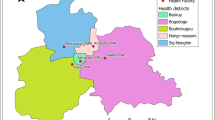Abstract
Dengue is emerging as a serious public health problem in Tamil Nadu. The present surveillance system is unlikely to generate proper information on the epidemiology of the disease, which is essential for planning and development of relevant control/preventive measures against dengue.Objective : Between November 2001 and January 2002, a descriptive study was undertaken on children with clinical dengue attending Kanchi Kamakoti Child Trust Hospital (KKCTH, a major private referral pediatric hospital in Tamil Nadu, India) to define the magnitude of dengue burden, the natural hostory of this disease in terms of clinical presentation, and outcome of the infections in hospitalized children (<15) with clinical dengue.Methods: The sera collected from patients analyzed for dengue specific IgM and IgG antibodies by IgM, IgG antibody capture enzyme linked immunosorbent assay (ELISA) using alternatively two commercial kits. World Health Organization clinical case definition was adopted to categorize the dengue confirmed children.Results: Dengue was diagnosed in 74.5% (143) of the 192 hospitalized children with clinical dengue. A considerable proportion (20%) of the total dengue infections were constituted by infants less than 1 yr of age. DF [dengue fever], DHF [dengue hemorrhagic fever] and DSS [dengue shock syndrome] were diagnosed in 65%, 11.2% and 23.8% of 143 dengue confirmed patients respectively. Though severe dengue (DSS + DHF) was present in 35% of the patients, the mortality rate was low during the study period due to timely diagnosis and clinical management of the patients.Conclusion: In developing countries like India, building of laboratory capacity for diagnosis and combat-mode ready preparedness for the management of dengue cases in emergency situation may reduce dengue-related mortality. This can be achieved in a wider scale through an integrated approach through the community, professionals and the public health departments.
Similar content being viewed by others
References
WHO. Dengue/dengue haemorrhagic fever.Weekly Epidemiological Report 75, 2000; 24: 193–200.
Cho-Min-Naing. Assessment of dengue hemorrhagic fever in Myanmar.Southeast Asian J Trop Med and Pub Hlth 2000; 31: 636–641.
Harris E, Videa E, Perez Let al. Clinical, Epidemiological and Virologic features of dengue in the 1998 epidemic in Nicaragua.Am J Trop Med and Hyg 2000; 63: 5–11.
Cherian T, Ponnuraj E, Kuruvilla Tet al. An epidemic of dengue haemorrhagic fever and dengue shock syndrome in and around Vellore.Indian J Med Res 1994; 100: 51–56.
Ram S, Khurana S, Kaushal Vet al. Incidence of dengue fever in relation to climatic factors in Ludhiana, Punjab.Indian J Med Res 1998; 108: 128–133.
Agarwal R, Kapoor S, Nagar Ret al. A clinical study of the patients with dengue hemorrhagic fever during the epidemic of 1996 at Lucknow, India.Southeast Asian J Trop Med and Pub Hlth 1999; 30: 735–740.
Kabra SK, Jain Y, Pandey RMet al. Dengue haemorrhagic fever in children In the 19% Delhi epidemic.Trans Roy Soc Trop Med and Hyg 1999; 93: 294–298.
Gombler S, Ramachandran VG, Kumar Set al. Hematological observations as diagnostic markers in dengue hemorrhagic fever —A reappraisalIndian J Pediatr 2001; 38: 477–481.
Aggarwal A, Chandra J, Aneja Set al. An epidemic of dengue hemorrhagic fever and dengue shock syndrome in children in Delhi.Indian J Pediatr 1998; 35: 727–732.
Vajpayee M, Singh UB, Seth Pet al. Comparative evaluation of various commercial assays for diagnosis of Dengue fever.Southeast Asian J Trop Med and Pub Health 2001; 32: 472–475.
Dengue haemorrhagic fever: Diagnosis, treatment and control, WHO 2nd ed. 1998; 2: 12–23.
Anuradha A, Singh NP, Rizvi SNet al. The 1996 outbreak of dengue hemorrhagic fever in Delhi, India.Southeast Asian J Trop Med and Pub Hlth 1998; 29: 503–506.
Wali JP, Biswas A, Handa Ret al. Dengue haemorrhagic fever in adults; a prospective study of 110 cases.Trop Doctor 1999; 29: 27–30.
Pancharoen C, Thisyakorn U. Dengue virus infection during infancy.Trans Roy Soc Trop Med and Hyg 2001; 95: 307–308.
Witayathawornwong, P. Dengue hemorrhagic fever in infancy at Petchabun hospital, Thailand.Southeast Asian J Trop Med and Pub Hlth 2001; 32: 481–487.
Lucas GN, Mendis SMMTGF. Dengue haemorrhagic fever in infancy. Sri Lanka.J Child Hlth 2001; 30: 96–97.
William BM, Gubler DJ, Harris E. Emergence and Global spread of a Dengue serotype 3, Subtype III virus.Emerging Infec Diseases 2003; 9: 800–809.
Author information
Authors and Affiliations
Corresponding author
Rights and permissions
About this article
Cite this article
Kabilan, L., Balasubramanian, S., Keshava, S.M. et al. The 2001 dengue epidemic in Chennai. Indian J Pediatr 72, 919–923 (2005). https://doi.org/10.1007/BF02731664
Issue Date:
DOI: https://doi.org/10.1007/BF02731664




